
www.thegospelcoalition.org
Go into All the World and Make Friends
My son recently asked me who my best friends are. I took a moment to think, then said, “My best friend in the U.S. is Reza and my best friend in Central Asia is Darius” (names changed for security). I smiled as I said it, realizing these two brothers from Muslim backgrounds—one a refugee and one a new pastor in his home city—really are two of my closest friends.
Humanly speaking, we shouldn’t be friends at all. But the gospel has done something remarkable in us, such that we now love one another with a deep and happy loyalty. For this, I’m indebted to these brothers who’ve so often pursued the relationship. I’m also indebted to my parents who modeled a deep love and friendship for the local believers they served as missionaries in Melanesia. When I eventually became a missionary, I naturally followed in their footsteps.
Yet when it comes to missions, few speak explicitly about the centrality of friendship. Of course, we might have close friends back home, our own Andrew Fullers who hold the ropes for us. Or we might value the close fellowship and camaraderie of teammates on the field. But we seldom consider how affectionate friendships of equality with locals are one of the primary goals and rewards of a life spent proclaiming the gospel among the nations.
Friendship with God
One way to describe the missionary’s goal is to see others become friends with the eternal God and his Son, Jesus Christ. This is the vertical side of friendship in missions. We shouldn’t lose sight of the scandal of this invitation. How can it be that rebellious sinners, lifelong enemies of God, are welcomed into friendship with the holy God they’ve so long spurned? Yet this is the language of the Bible.
Abraham, the father of all who are saved by faith, is called a friend of God (James 2:23). Jesus was known as the friend of sinners (Matt. 11:19). He explicitly tells his disciples they’re no longer only servants but friends (John 15:13–15).
As a missionary, I have the privilege of seeing Central Asians befriended by God. That’s my goal. It’s also my reward.
Befriending Locals
In faithful cross-cultural ministry, we invite the nations into friendship with God. However, by virtue of their new relationship with Christ, they should also become friends with us. This is the horizontal side of friendship in missions; not only does God gain new and eternal friends but so do we. At least we will if we follow in the footsteps of Paul, whose ministry overflowed with affectionate friendship toward those who believed the gospel.
This is the horizontal side of friendship in missions; not only does God gain new and eternal friends but so do we.
Paul didn’t only give the gospel to local believers; he shared his life with them (1 Thess. 2:8). He didn’t limit himself to ministry relationships or even task-focused partnerships. In addition to being their loving father in the faith, he became their devoted friend (Acts 24:23).
We see this friendship through Paul’s constant, thankful, joyful prayers for local believers. We see it in his unembarrassed professions of affection and longing to spend time with them (Phil. 1:3–4, 8; 1 Thess. 3:6, 10). Paul truly held these believers in his heart, delighting in them in person while also doing his best to stay in touch with them from a distance (Phil. 1:7; 4:21–22; 1 Cor. 16:7). He lived sacrificially for them and allowed them to care for his needs (Phil. 2:17; 4:16). He treated them as equals, calling them brothers. He was proud of them, calling them his crown (4:1). Paul and his friends even wept with and for one another (Acts 20:37).
Problem of Self-Protection
But we must be honest about something. When you talk to local believers in many missions contexts, they’ll tell you missionaries seem hesitant to enter into this kind of close friendship with them. Many try to keep a safer relational distance from locals.
Why is that? Maybe it’s because missionaries know they’re transient. This is perhaps an act of self-protection in a lifestyle given to so many costly goodbyes. Others may struggle to befriend locals out of confusion about what healthy boundaries are. Sadly, some may quietly despise the culture or even unconsciously look down on locals. Whatever the reason, missionaries should try to understand why they’re keeping locals at arm’s length—then repent.
As one of my pastors in Central Asia recently told me, the diversity of our friendships is meant to display the gospel’s beauty. Wealthy local friends should marvel that you also befriend the street cleaner. And your fellow countrymen back home should be surprised by the depth of your friendships with local believers whose backgrounds are so different from your own.
Worth the Risk
Missionaries may be effective in many aspects of their ministry with locals. They may have solid partnerships, even a level of trust. But that’s not the same as risking the vulnerability and equality that characterizes true spiritual friendship. It’s not the same as the shared delight that missionaries have with those from their own culture. And locals can tell the difference.
The diversity of our friendships is meant to display the gospel’s beauty.
However, the most beloved (and hence effective) missionaries are genuine friends with the local believers. Yes, this will make missions more costly. Sin, betrayal, and abandonment will break your heart when you’ve entrusted it to local believers. I’ve gone through seasons when I dared not risk such friendships. Too many had left, had failed, had turned on us when we needed them most. Yet I’m so glad the Lord didn’t leave me in that place but gently brought my heart back to a posture of vulnerability—and I once again tasted the sweet rewards of affection.
Some of my fondest moments as a missionary have been when my Central Asian friends and I dream together about the new heavens and earth. We talk about how much we look forward to being there together with Jesus, telling stories, and sipping New Jerusalem chai. If our friendship now with one another and with Jesus is such a kind gift—such an undeserved reward—then just imagine what it’ll be like in the resurrection.
Go Make Friends
The Scottish missionary John Paton knew the costs and rewards of friendship on the mission field. He also anticipated the joys of those friendships perfected in glory. Recounting the death of his friend Chief Kowia, he writes,
Thus died a man who had been a cannibal Chief, but by the grace of God and the love of Jesus changed, transfigured into a character of light and beauty. I lost, in losing him, one of my best friends and most courageous helpers; but I knew that day, and I know now, that there is one soul at least from Tanna to sing the glories of Jesus in Heaven—and, oh, the rapture when I meet him there!
Friendship is one of the primary goals and richest rewards of missions. I’m convinced faithful missionaries should exhibit a posture of humility and vulnerability, pursuing affectionate and mutual love with local believers. Because we don’t go to the ends of the earth only to make disciples. We also go to make friends.

















